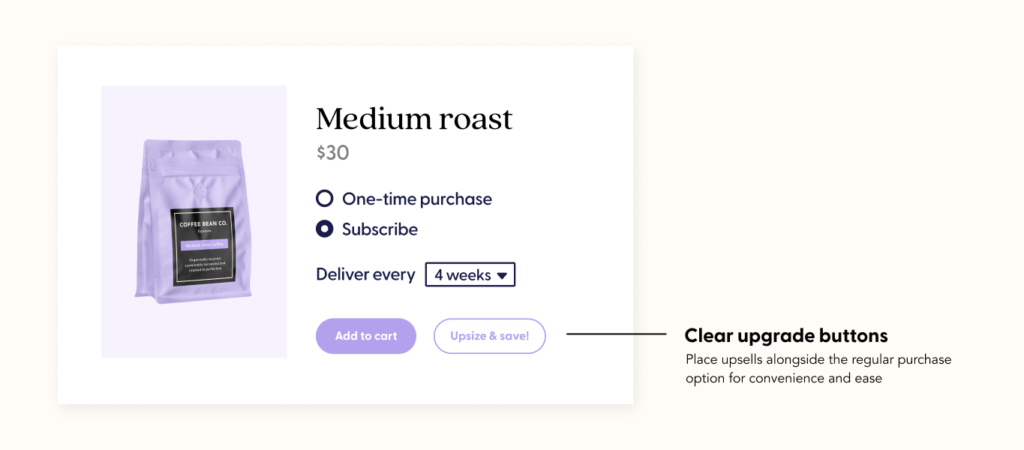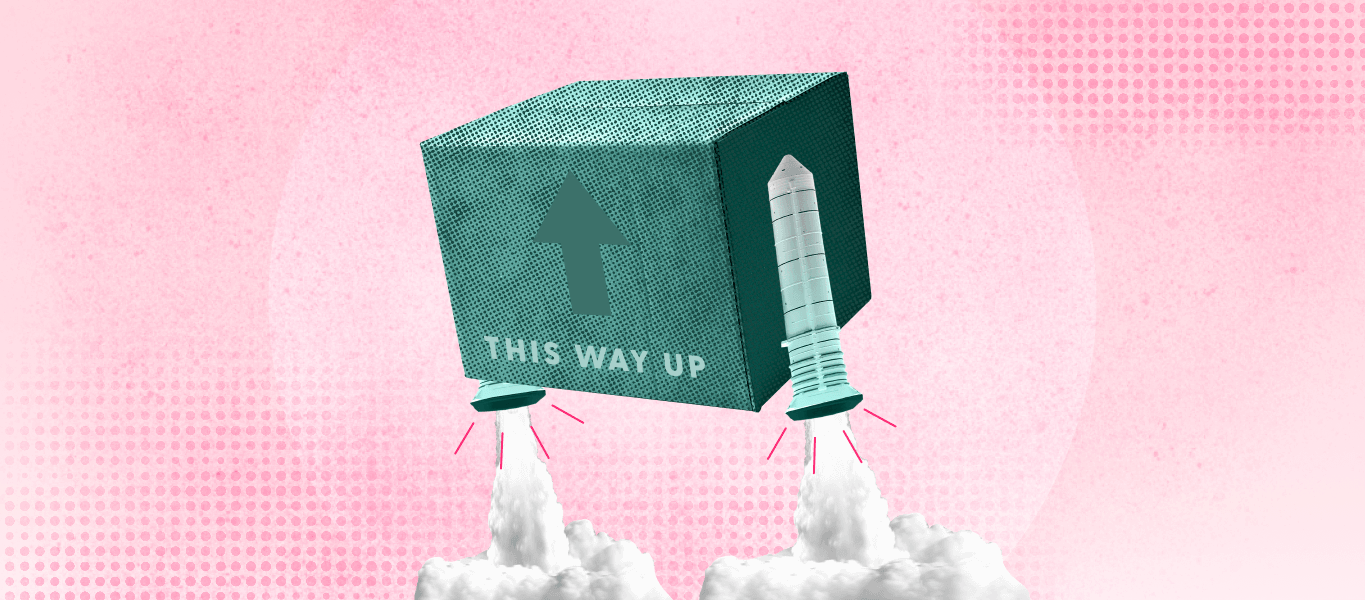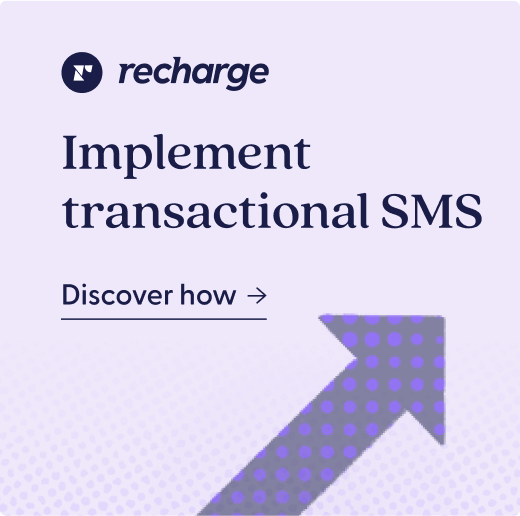There’s no secret weapon to increase sales for your ecommerce business—but there are several best practices you can follow, and upselling is a crucial one. This sales and marketing tactic is a powerful strategy for adding value for both your store and your customers.
On the business end, upselling can be leveraged to increase average order value (AOV) and customer satisfaction. For your customers, upselling can offer financial advantages and allow shoppers to find their perfect product matches easily and quickly, saving them time and money.
So—what are some techniques for effective upselling, and what might upselling look like for your ecommerce business? In this post, we’ll dive into the essentials of upselling, including proven upselling strategies you can apply to your own business.
Key takeaways
- Upselling is a sales tactic that attempts to increase the value of a customer’s order through product or service upgrades.
- Upselling should not be confused with cross-selling, a separate but related strategy involving add-on products.
- Personalization is key to effective upselling.
- When done effectively, upselling has the power to increase AOV for your store.
What is upselling?
As it’s defined in our ecommerce glossary, upselling is a sales technique that “offers customers a personalized product recommendation, based on their intended purchase, that provides more benefits for a price increase.”
Essentially, upselling is marketing upgrades to your customers. Rather than adding on to a customer’s initial purchase, this more premium product is meant to replace the customer’s initial purchase, offering more benefits for more money.
One of the major advantages of upselling is increasing AOV for your online store—but it doesn’t stop there. When developed and executed effectively, your upsell strategy has the power to:
- Strengthen customer relationships
- Increase brand loyalty
- Boost customer lifetime value (LTV)
Cross-selling vs. upselling
Upselling should not be confused with cross-selling, a related but separate strategy that also attempts to increase the value of a customer’s order through targeted product recommendations. The difference: While an upsell aims to replace a customer’s original purchase, a cross-sell aims to add on to a customer’s original purchase with extra products or services.
In other words, cross-selling is convincing customers to purchase add-on products that complement an item in their cart. For example, if someone is planning to purchase a bag of coffee beans, cross-selling might mean offering them the ability to add a special coffee creamer to their cart, as well. Upselling, on the other hand, could mean offering the customer the ability to swap out the beans in their cart for a more expensive single origin blend.
For a truly successful marketing strategy, ecommerce businesses should utilize both cross-selling and upselling, as the two have different use cases. However, in this post, we’ll focus specifically on upselling strategies you can implement for your business.
Real life examples of upselling
Upselling can take many different forms depending on the products and services you offer. Before we dive into the strategies for effective upselling, let’s back up and take a look at a few of the best upselling examples.
In your everyday life, you probably encounter upselling quite frequently. When you’re buying plane tickets and you’re given the option to upgrade to a first class seat, that’s upselling in action. Also upselling? When a hotel offers you an ocean view room instead of a standard view room for a rate increase, or when an acupuncture studio offers you the ability to purchase a pack of five sessions rather than just one.
For an ecommerce store, upselling might take the form of marketing more profitable services to your subscription customers. Let’s say you’re a meal kit company with plans for two, four, and six meals a week. If the four meal option is more cost effective for your business to produce, you can upsell it to customers who are currently buying the two meal plan for a slightly higher price, adding value for both parties.
How to track your AOV & why this matters
Because one of the major benefits of upselling is increasing AOV, a crucial first step in your upselling journey is to make sure you have the analytics in place to effectively track your AOV. Make sure to establish a baseline for your business prior to implementing any new upselling strategies.
From there, be sure to monitor your AOV over time, keeping an eye out for any increases or decreases that might arise as a result of your marketing efforts. This can help you assess how effective your upselling strategy is for your unique customer base. From there, you can more easily identify areas of improvement or strategies that are working well and should be implemented elsewhere.
For a more in-depth look at AOV tracking, some businesses may benefit from segmenting their customer base into more specific groups. This can also allow you to tailor your upselling to different customer groups with varying traits, and even identify new service opportunities down the line to market to those customers. After all, as we’ll get into in this next section, upselling is most effective when it is personalized.
7 highly effective upselling techniques for increasing AOV
As we mentioned earlier, different upselling techniques can vary greatly from business to business depending on the types of products or services you offer. However, regardless of your product vertical, there are several upselling tips and best practices to keep in mind to make your efforts as effective as possible.
1. Take personalization seriously
The most important upselling technique you can use is to personalize your product recommendations. The more you can tailor your recommendations to individual customers or groups of customers, the more likely they are to take you up on your suggestion and upgrade their order.
To tackle personalization, it’s key to consider things from your customers’ point of view. Solicit feedback from them so you can identify their priorities and pain points, as upsells are far more effective when they offer solutions to a customer’s problem.
You can personalize your upsells based on individual customers’ order history, but it doesn’t stop there. You can also use segmentation to parse out different customer groups based on specific traits, like where your customers live, and provide any recommendations from there.
2. Upsell to your existing customers
Upselling is most effective when it is conducted with your existing customer base. Of course, you can upsell to prospective customers as well—but current customers already have a relationship with you, making them more likely to trust your brand and take you up on your recommendations.
This also gives you access to their purchase history to aid in your personalization efforts, and can make it easier to get feedback from them, giving you the opportunity to pivot your strategy in ways that are directly informed by your customers.
According to Accenture, 91% of consumers are more likely to shop with brands who recognize and remember them, and provide them with relevant offers and recommendations. Remember: Your most valuable existing customers are your subscribers, whose relationships with you are recurring by nature. Be sure to tap into their wisdom and prioritize their experiences to get even more value out of your upselling efforts.
3. Offer reasonable upgrades
Because an upsell offer is meant to replace a customer’s original order, be sure that it doesn’t stray too far from that original order, both in terms of price and quantity. Most customers will be hesitant to swap out their intended purchase for something far more expensive than what they originally budgeted for.
For example, if your customer has a variety pack of three bags of potato chips in their shopping cart, try offering them a variety pack of six bags of potato chips. This is still fairly close to the price and size of their original purchase, increasing the likelihood that the upsell will be effective.
4. Emphasize your subscription options
Any products that you offer both via subscription and as one-time purchases have a built-in opportunity for upselling. If a customer intends on purchasing the item just once, you have a natural chance to sell them on the subscription offering to boost sales.

Here, an important upselling technique is to emphasize the subscription option to entice customers to upgrade. This could mean having clear upgrade buttons right alongside the “add to cart” button for a one-time product that can be converted into a subscription. Depending on the products you offer, it could also mean listing the subscription option before the one-time purchase option.
5. Make your upsells accessible
Customers are more likely to upgrade their original purchase if it is easy for them to do so. One way to create this sense of ease is by offering upselling opportunities at multiple points in the shopping journey—for example, on your product detail pages, in your customer portal, and on the checkout page itself.
Focusing on your omnichannel strategy is another way to make your upselling options accessible. Make sure it’s easy for your customers to upgrade their purchase whether they’re using a desktop computer or their mobile device. You can even consider transactional SMS services so customers can upgrade with a quick text, without even having to log on to their account.
6. Showcase any cost savings for the customer
A key element of upselling is that customers get better value out of the upgraded option than they would have with their original purchase. You could offer free shipping for customers who purchase a higher-value subscription plan, an extra discount for subscribing rather than purchasing an item one time, or gift customers with a complimentary product if they choose to upgrade.
Regardless of the added value of your upselling offers, be sure that you communicate this clearly and succinctly for your customers. Make it immediately clear to them what the monetary benefit is to upgrading their order—don’t make them work to read through large sections of text to find this crucial information.
7. Strategically limit options
When developing your upsell techniques, it’s crucial to strike the right balance of options. More isn’t always better—in fact, when you present your customers with too many choices for upgrades, they might not accept your upsell offers at all and could even abandon the shopping process altogether if it is too confusing or overwhelming.
To avoid this overwhelm, present just a few key options, and focus on the quality of your recommendations. Hone in on products that already sell well, and be sure that they’re personalized to suit your customer base.
This way, your upsells not only offer financial value for your customers—they also save online shoppers time by directing them quickly and easily to their best product match.
Upselling isn’t just a sales technique—it’s a relationship-building tool
The benefits of an effective upselling strategy don’t just stop at increased AOV and LTV. When developed effectively and tailored to your unique customer base, upselling is a key way to strengthen your customer relationships, allowing you to retain customers more effectively and instill trust in your brand. And for subscription businesses who rely on lasting customer relationships to fuel their recurring revenue stream, this relationship-building aspect is especially crucial.
Be sure to monitor your AOV over time and solicit customer feedback regularly to ensure that your upselling techniques are resonating with your customer base. In the end, the results will speak for themselves.



